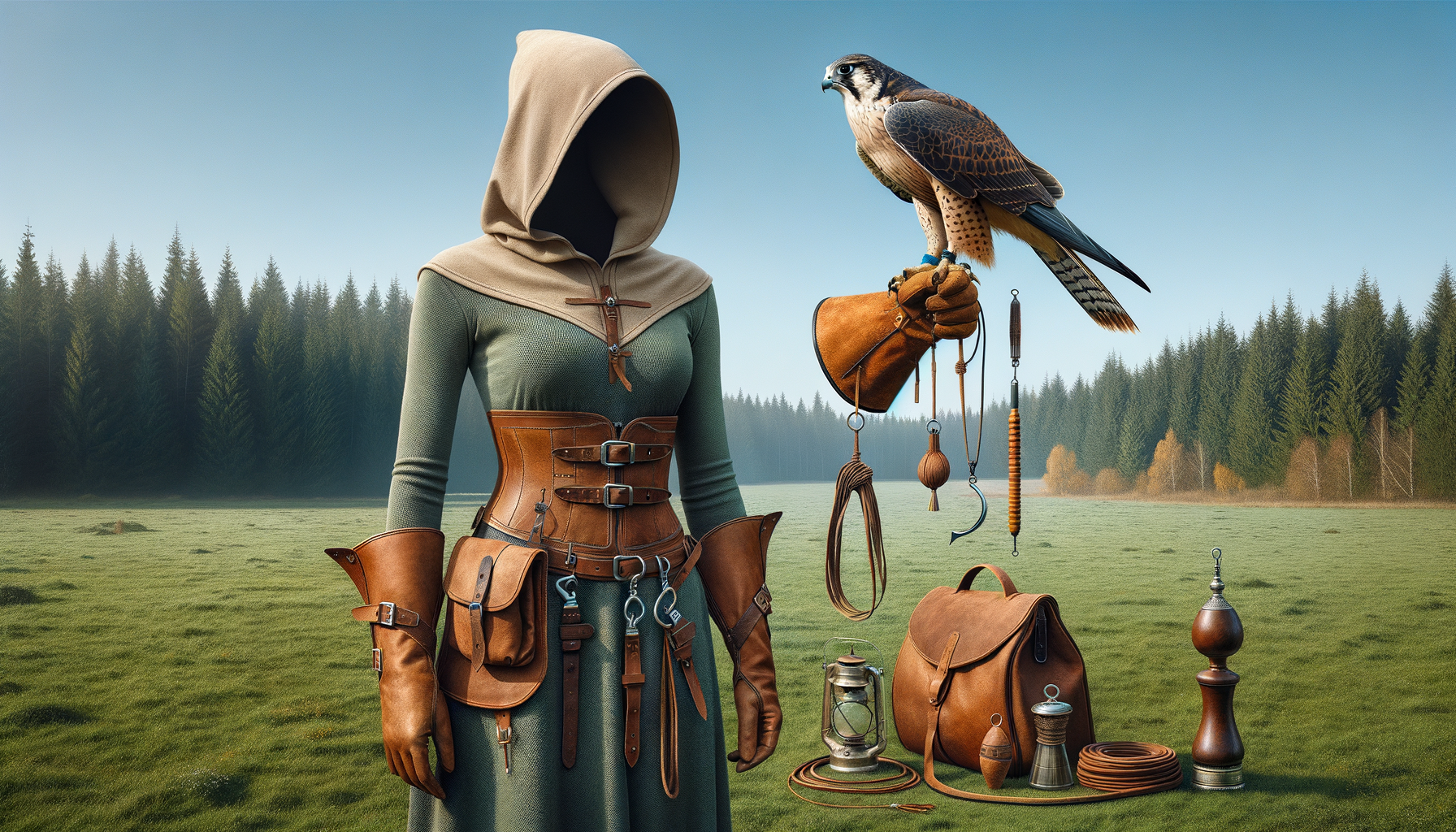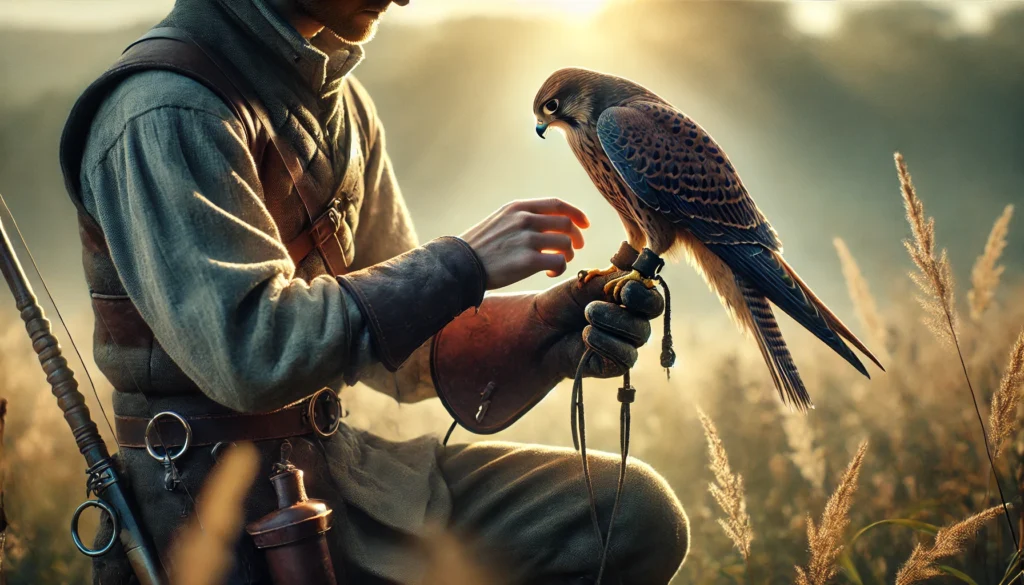Essential Falconry Equipment
- Gauntlet (Glove): A special glove to protect your hand while handling birds of prey.
- Hood: A covering for the bird’s head to help keep it calm.
- Jess: Leather straps attached to the bird’s legs for control.
- Lure: A leather or fabric decoy used to train and exercise the bird.
- Bell: A small bell attached to the bird to help locate it when flying.
- Perch: A place for your bird to rest comfortably when not flying.
- Scale: A tool to weigh the bird and monitor its health.
- Telemetry: A tracking device used to locate the bird if it flies too far.
- Creance: A long, lightweight cord used during training flights.
- Falconry Bag: A bag to carry all necessary equipment.
Essential Falconry Equipment: Your Path to Becoming a Falconry Enthusiast
Welcome to the magical world of falconry! Imagine you’re an explorer setting out on an epic journey through the enchanting landscapes of Ireland. Just as you wouldn’t embark on such an adventure without your trusty map, compass, and walking stick, stepping into the realm of falconry requires some essential gear to make your experience truly extraordinary.
At Learn Falconry, we believe that understanding and equipping yourself with the right tools is the first step toward forming that special bond with your majestic bird of prey. From jesses to hoods, each piece of falconry equipment plays a vital role, just like each part of a traditional Irish jig contributes to the beauty of the dance.
In this article, we’ll delve into the fascinating world of falconry equipment and uncover why each item is integral to the art of falconry. So, why keep reading? Because, like the intricate patterns of a Celtic knot, every detail matters, and equipping yourself with the right knowledge will ensure that you and your feathered companion can soar to new heights with confidence and grace.
Comprehensive Falconry Equipment Guide: Essential Gear and Tools
Welcome to our detailed falconry equipment guide! Whether you’re a seasoned falconer or just getting started, understanding the right falconry gear is crucial for both training and caring for your bird of prey. This guide will answer essential questions such as “What equipment is used in falconry?” and help you identify “What is the best falconry glove?” Let’s dive into the fascinating world of falconry tools and equipment.
Essential Falconry Gear
Falconry requires a range of specialized equipment to ensure the safety, health, and effective training of your falcon. Understanding these tools will help you become more proficient in the art of falconry. Here are the key items you need:
Falconry Glove
The falconry glove is one of the most important pieces of falconry equipment. It protects your hand while providing a perch for your falcon. When choosing the best falconry glove, consider the material and fit. Leather gloves are highly recommended for their durability and comfort. You can learn more about selecting the right glove in our detailed guide “What is the best falconry glove?”.
Jesses and Leashes
Jesses are thin straps that attach to the falcon’s legs, allowing you to secure your bird and prevent it from flying away. Leashes attach to the jesses and to your glove or perch. Choosing high-quality jesses and leashes is crucial for the safety of both you and your falcon. Explore more about the different types of jesses and leashes in our comprehensive article here.
Hoods
Hoods are used to cover a falcon’s eyes to keep it calm and avoid distractions. They are an essential part of the falconry equipment list, especially for training and transportation. A well-fitted hood ensures that the falcon remains calm and stress-free. Check out our extensive information on hoods here.
Perches
Perches provide a resting spot for your falcon when it’s not in flight. Effective perches mimic natural resting positions and contribute to the bird’s comfort and health. Different styles suit various environments, from indoor to outdoor settings. For a closer look at different types of perches, visit our article here.
Lures
Lures are essential training tools used to simulate prey during falcon training sessions. They help teach the bird hunting techniques and conditions it to return to the falconer. Learn more about the different types of lures and their uses here.
Advanced and Modern Falconry Tools
As falconry has evolved, so has the equipment. Today’s falconers have access to advanced tools that enhance training and tracking efforts.
Bells and Telemetry
Bells are attached to the falcon’s legs to help track its movements during flight. Telemetry systems use radio signals to locate your bird over longer distances, ensuring you can find your falcon if it flies out of sight. Discover more about bells and telemetry here.
GPS Trackers
Modern falconry has seen the introduction of GPS trackers, providing real-time location data on your bird’s whereabouts. These trackers are especially useful for long-distance and high-performance falconry. Get detailed insights about GPS tracking devices here.
Explore more about the varied and intricate falconry gear and tools used in the practice by visiting our extensive falconry equipment guide.
Safety and Maintenance of Falconry Equipment
Proper maintenance and safety of falconry equipment ensure longevity and effective use. Regular cleaning and proper storage are essential practices. To help you keep your equipment in top condition, explore our tips and tools for maintenance here.
For beginners or those looking to enhance their falconry knowledge, we offer numerous resources, such as Falconry for Beginners and Advanced Falconry. Dive deep into specific topics like training a falcon or exploring different species of falcons.
Embarking on the thrilling journey of falconry is not only about skill but also about having the right equipment. At Learn Falconry, we’re dedicated to providing all the information you need to succeed in this ancient and noble practice.
Exploring Falconry Equipment
Falconry, the ancient sport of hunting with birds of prey, requires specialized equipment to ensure both the safety and effectiveness of the practice. At Learn Falconry, we provide everything you need to get started, from beginner kits to advanced gear. Let’s delve into the specifics of the essential equipment a falconer needs.
Key Equipment for Falconry
Kangaroo Leather
One of the essential materials in falconry is kangaroo leather due to its durability and flexibility. It is used in making gloves and jesses, which are crucial for handling birds.
Perches
Perches are necessary for housing and training raptors. They come in various designs, including bow perches and block perches, tailored to different bird species. The right perch ensures the bird’s comfort and prevents foot problems.
| Perch Type | Main Use | Common Material |
|---|---|---|
| Bow Perch | Training | Metal/Wood |
| Block Perch | Housing Larger Birds | Concrete/Wood/Plastic |
Hoods
Hoods are used to cover a bird’s head, helping to keep it calm during handling and transportation. They come in different sizes and styles, and it’s vital to choose one that fits well.
- Falcon Hoods: Typically have a flat top for falcons.
- Hawk Hoods: Rounded top, suited for hawks.
Telemetry
Telemetry involves using transmitters and receivers to track the bird’s location. This is crucial in modern falconry for monitoring health and ensuring the bird’s safety during flights.
Lure
A lure is employed during training and hunting to attract the bird. It often resembles the prey the bird is trained to hunt and is a pivotal part of the bird’s training regimen.
Leash and Swivel
These tools are used for safe and controlled handling of the bird. They are crafted to provide security while allowing the bird some freedom of movement.
| Item | Purpose | Material |
|---|---|---|
| Leash | Secure handling | Leather/Nylon |
| Swivel | Prevent tangling of the leash | Stainless Steel |
Housing for Raptors
Mews
Mews are specialized enclosures where raptors are housed. These structures are vital for the bird’s physical health and psychological well-being.
Indoor Housing
Recommended for species like kestrels due to their delicate weight management needs. Indoor setups help in closely monitoring their diet and health.
Redtail Housing
Housing a redtail hawk often requires additional planning and coordination, possibly with another falconer, to ensure a secure and optimal environment.
Initial Costs
Starting with falconry involves significant initial investments.
- Apprentice Kit: For beginners, an apprentice kit costs around $230.
- Digital Scale: Necessary for weighing the bird, commonly available online.
The total initial cost of getting started in falconry ranges between $1000 to $1500, depending on factors like location and bird species.
Licenses Needed
Falconry Examination
To start practicing falconry, one needs to pass an examination, typically free of charge.
Apprentice License
This license, required for training under a sponsor, costs about $40 for five years.
| License Type | Experience Required | Cost | Benefits |
|---|---|---|---|
| Apprentice | No prior experience | $40/5yrs | Allows training under a sponsor |
| General | Experience required | Varies | More flexibility in bird choice |
| Master | Extensive experience | Varies | Up to 13 raptors allowed |
Additional Falconry Tools
- Jesses and Equipment: Essential for handling birds, these include items like leash, swivel, and bath containers.
- Game Bags: Ergonomic and ventilated bags designed to carry gear and game.
- Anklets and Bells: Used for identifying and protecting the bird while it’s in the wild.
Up-to-Date Falconry Guides
Updated guides in 2024 offer detailed illustrations and text to help both beginners and experienced falconers.
| Guide Feature | Benefit |
|---|---|
| Illustrations | Easy understanding of equipment use. |
| Photos | Real-life examples for better clarity. |
| Price Range | $15 – $35 |
By understanding and investing in the right equipment, you can embark on a fulfilling journey in falconry, ensuring the wellbeing and performance of your bird. Happy hawking!
Essential Falconry Equipment for Every Enthusiast
Falconry is a captivating blend of ancient tradition and modern practice, requiring specialized equipment to ensure the safety and well-being of both the bird and the falconer. As we’ve explored, some key items are indispensable for anyone passionate about this noble sport.
Field and Training Gear
Gloves made from high-quality leather, such as elk, deer, or cowhide, are fundamental. These gloves offer the perfect balance of protection and flexibility, ensuring your hands stay safe while handling your raptor. Alongside gloves, hoods, telemetry equipment, and perches are critical for training and managing your bird’s location, comfort, and health.
Housing and Miscellaneous Equipment
Housing your raptor properly is essential, requiring enclosures like mews and indoor spaces for smaller birds like kestrels. Don’t forget additional essentials such as leashes, swivels, and a reliable digital scale to monitor your bird’s weight accurately.
Falconry Licenses and Guides
Beginning your falconry journey involves practical know-how and legal requirements. Apprentice kits are a helpful starting point, costing around $230, with total investment potentially reaching $1500. Additionally, up-to-date falconry guides, priced between $15 and $35, provide valuable insights into gear and techniques to help you excel.
The Final Takeaway
Embarking on a falconry journey requires thoughtful preparation and the right tools. Quality equipment ensures safety, effective training, and a deeper connection between you and your raptor. As you gather your gear and knowledge, remember that this investment not only supports your passion but also honors the timeless tradition of falconry.



